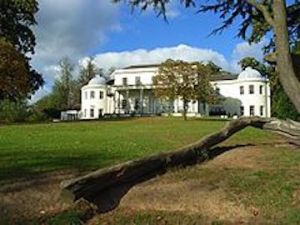The following post is the first of a series based on information obtained from a fascinating book Susana recently obtained for research purposes. Coaching Days & Coaching Ways by W. Outram Tristram, first published in 1888, is chock full of commentary about travel and roads and social history told in an entertaining manner, along with a great many fabulous illustrations. A wonderful find for anyone seriously interested in English history!
Frances Kendrick: The Berkshire Lady
As we follow the Bath Road, Tristram recounts the story of Frances Kendrick, a nineteen-year-old young lady who is fortunate to be not only beautiful and gracious, but also very wealthy and, atypical for the time, retains full control of her life and her fortune. Not surprisingly, nearly every young man she meets falls in love with her and offers her marriage. Many of them are exceedingly eligible, but she turns them all down because she doesn’t reciprocate their feelings. Most young ladies would have felt under pressure to choose one, but Frances has no parents and thus no reason to do so.
Eventually, the rejected suitors get together and start a rumor that Miss Kendrick deliberately leads them on so that she can enjoy their misery when she refuses their offers of marriage. It is all nonsense done out of spite, of course, but it has the effect of nearly ruining her chance of finding true love.
Benjamin Child, Esq. is a workaholic, poverty-stricken barrister who also happens to be unpretentious and quite good-looking himself. Like all the rest, he is instantly attracted to the lovely heiress, and she to him, to the point where her rejected suitors decide to put a spanner in the works by taking him aside and telling him that Miss Kendrick is a soulless thief of hearts. Benjamin doesn’t like the idea of being considered a fortune-hunter anyway, so he takes off for London and tries unsuccessfully to forget about Frances Kendrick.
Poor Frances is heartbroken. She has finally found the gentleman of her dreams, and he doesn’t seem to share her feelings. After discovering the rumors being circulated about her, she is desperate to find a way to prove to him that her character has been unfairly tarnished and that she truly loves him. But how can she do that when he won’t come near her?
What she does sounds like a scenario in a historical romance, but it really did happen! Frances issues a challenge to Mr. Child to fight a mortal duel in Calcott Park (part of her estate). Despite the fact that the challenge gives no pretext for the duel, Mr. Child shows up and finds himself facing a masked, cloaked young lady with a sword who tells him in no uncertain terms that he can either fight her or marry her. By this time, he has discerned her identity and, pleased to find that she returns his feelings, agrees to marry her with a special license in St. Mary’s Church, Walgrave.
I love a good legend, and what a treat to discover it really did happen!
Frances Kendrick and Benjamin Child were married March 28, 1707 at St. Mary’s Church in Wargrave, as you can see for yourself in the parish register. When Frances died in 1722, her eccentric husband had her placed in a lead coffin shaped to follow exactly the lines of her body, which was laid to rest in the Kendrick family vault at St. Mary’s Church in Reading. (The coffin was found and examined in 1820.)
Benjamin sold Calcott House (although he later refused to move out of it and the new owner had to destroy the house to get him out of it), and later moved to a farm on the estate that he remodeled and became what is now known as Prospect House. It is here where the ghost of the Berkshire Lady is said to roam, seeking her true love.
You can read the famous ballad of the Berkshire Lady here. Even better, you can read an 1879 fictionalized version of the story by Katherine Sarah MacQuoid on Google here. (I heartily recommend it!) More details about the story behind the legend are here.
Index to all the posts in this series
1: The Bath Road: The (True) Legend of the Berkshire Lady
2: The Bath Road: Littlecote and Wild William Darrell
3: The Bath Road: Lacock Abbey
4: The Bath Road: The Bear Inn at Devizes and the “Pictorial Chronicler of the Regency”
5: The Exeter Road: Flying Machines, Muddy Roads and Well-Mannered Highwaymen
6: The Exeter Road: A Foolish Coachman, a Dreadful Snowstorm and a Romance
7: The Exeter Road in 1823: A Myriad of Changes in Fifty Years
8: The Exeter Road: Basingstoke, Andover and Salisbury and the Events They Witnessed
9: The Exeter Road: The Weyhill Fair, Amesbury Abbey and the Extraordinary Duchess of Queensberry
10: The Exeter Road: Stonehenge, Dorchester and the Sad Story of the Monmouth Uprising
11: The Portsmouth Road: Royal Road or Road of Assassination?
12: The Brighton Road: “The Most Nearly Perfect, and Certainly the Most Fashionable of All”
13: The Dover Road: “Rich crowds of historical figures”
14: The Dover Road: Blackheath and Dartford
15: The Dover Road: Rochester and Charles Dickens
16: The Dover Road: William Clements, Gentleman Coachman
17: The York Road: Hadley Green, Barnet
18: The York Road: Enfield Chase and the Gunpowder Treason Plot
19: The York Road: The Stamford Regent Faces the Peril of a Flood
20: The York Road: The Inns at Stilton
21: The Holyhead Road: The Gunpowder Treason Plot
22: The Holyhead Road: Three Notable Coaching Accidents
23: The Holyhead Road: Old Lal the Legless Man and His Extraordinary Flying Machine
26: Flying Machines and Waggons and What It Was Like To Travel in Them






Coaching Days and Coaching Ways is a brilliant book. Mine is the 1894 edition. There is also comment on the Railways. Which killed the coach trade.
LikeLike